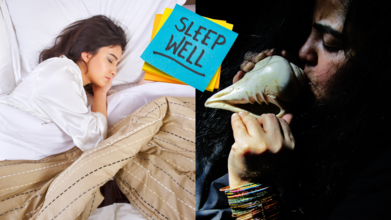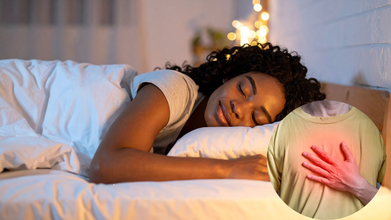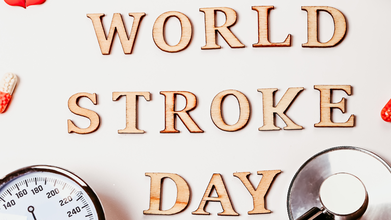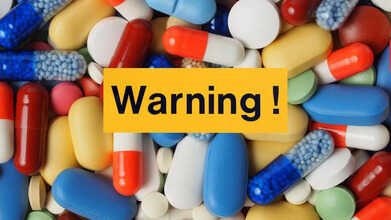- Health Conditions A-Z
- Health & Wellness
- Nutrition
- Fitness
- Health News
- Ayurveda
- Videos
- Medicine A-Z
- Parenting
- Web Stories
Want To Sleep Better? Try Blowing Through A Conch Shell, Says Study

When it comes to tackling sleep problems, most of us think of lavender sprays, blackout curtains, or maybe a warm cup of chamomile tea. But a group of scientists in India has now suggested blowing through a conch shell. In India, blowing it has always been a sacred thing. Ladies and pundits blow the shell on auspicious occasions and at several places and times; it is also blown to kickstart something, like an event or a house-warming ritual. So, many Indians are quite adept at this ancient practice, but it turns out this could also help you sleep better.
According to a new study published in the journal ERJ Open Research, this practice, also known as shankh blowing, could help people with obstructive sleep apnoea (OSA) breathe easier, sleep deeper, and wake up more refreshed.
OSA is no ordinary snoring. It is a condition where your airway collapses repeatedly during sleep, causing brief breathing interruptions called apnoeas. Aside from leaving you exhausted, it is linked to high blood pressure, heart disease, and even mood disorders.
Also Read: Ozempic Users Found To Age Back By More Than 3 Years, Finds New Trial; Peer Review Pending
The most common treatment is a CPAP machine, a bedside device that blows air into your airway through a face mask, keeping it open through the night. While effective, many patients find it awkward, noisy, or downright uncomfortable. That is where the humble conch shell sounds more helpful.
What Exactly Is Shankh Blowing?
Besides its use in rituals and ceremonies in Indian practices, the shankh, a spiralling conch shell, is used in yoga breathing exercises. The technique for OSA therapy is surprisingly simple:
- Take a deep breath in.
- Purse your lips tightly against the shell’s mouthpiece.
- Blow forcefully and sustain the sound until your lungs are almost empty.
The act creates strong vibrations and airflow resistance, which the researchers believe strengthens the muscles of the upper airway, particularly the throat and soft palate. These are the exact areas that tend to collapse during sleep in people with OSA.
The conch’s spiral shape may also produce specific acoustic and mechanical effects that stimulate and tone these muscles even more.
Inside the Study
The research team worked with 30 people between the ages of 19 and 65, all diagnosed with OSA. They were split into two groups:
- Group A: Practised shankh blowing.
- Group B: Did standard deep breathing exercises.
Compared to the deep-breathing group, the shankh blowers were 34 per cent less sleepy during the day and typically experienced four to five fewer apnoeas per hour. That is a significant improvement for a technique that requires no wires, no electricity, and no sleep-tech gadgets cluttering the bedside table.
Why It Works
While more research is needed, scientists think it comes down to muscle training. Just as resistance bands tone your arms, blowing through the shankh provides resistance training for your airway. Stronger throat and palate muscles are less likely to sag and block airflow during sleep.
It is also possible that the rhythmic breathing pattern and sound vibrations have a calming effect, helping to set the stage for deeper, more restorative sleep.
But before you swap your CPAP machine for a seashell, the researchers caution that this was a small-scale study. While the results are promising, they are not yet strong enough to replace standard medical treatments. A larger trial involving several hospitals is already in the works to confirm the benefits.
Still, for people who cannot tolerate CPAP or are looking for a complementary approach, shankh blowing could be worth a try, especially since it is inexpensive, low-risk, and does not require a power socket.
How to Give It a Go
1. Get a conch shell
2. Clean it well before use.
3. Sit comfortably with your back straight.
4. Take a slow, deep inhale.
5. Seal your lips around the shell’s opening.
6. Blow with steady force until you’ve exhaled almost completely.
7. Rest for a few seconds, then repeat for 10–15 minutes.
It is best to start slowly and work up to longer sessions; your throat muscles will need time to adapt. And of course, check with a healthcare provider before beginning if you have any respiratory or heart conditions.
Not Turning Off The Light At Night Could Be The Top Cause Of Death Worldwide, Finds Study

Credits: Canva
Nighttime Light Exposure: How you spend the night sleeping whether with the light on or off, could actually determine how long you live. A new study published in JAMA Network Open finds that turning off the lights at night is not just good for a restful sleep, but it could lower the risk for cardiovascular disease, which is a top cause of death worldwide.
What Did The Study Find?
The new research found that people who slept in the brightest conditions, especially with having overhead bedroom lights on, had a 56% greater risk of developing heart failure. Those who slept under such an intense light also had a 32% increased risk of coronary artery disease and a 28% increase of stroke.
Also Read: The 'BEFAST' Trick Could Help You Detect Your Stroke Before It Happens, According To Doctor
How Was The Study Conducted?
The study tracked its participants through wrist wearable. The exposure to light intensity between 12.30am to 6am was measured, as said by Dr Daniel Windred, co-first author of the study. He is a research associate at Flinders University's College of Medicine and Public Health in Australia.
“One limitation is that we do not know the sources of personal light exposure, only the intensity,” said Windred. “Understanding typical sources of night light exposure might allow for more informed recommendations beyond ‘avoid bright light at night.’”
The study analyzed 13 million hours of light data, which came from 89,000 people.
Why Does Turning The Light Off At Night Protects You From Cardiovascular Diseases?
The explanation lies in the brain's production of sleep-inducing hormone melatonin, which can be blocked by the light. This is why reducing light exposure at night could make you sleep better. It also means to limit screen time as much as possible and switch off unnecessary household lights within four hours of bed time.
Windred says that if turning the light off is not possible, you may try to dim it down or use warm lighting, instead of bright overhead lights. Another thing that must be followed is to avoid using bright alarm clocks, and sleeping near windows, as lights could come through that. In case that too is not possible, you may use light-blocking window shades, or blackout curtains, and even your sleep mask on your eyes.
Circadian rhythms are 24-hour cycles "in virtually every cell and tissue in our body, including our cardiovascular system," said Windred. This internal clock helps you sleep and also wake up, especially by detecting light as a signal.
Disruption of circadian rhythms by light has been shown to interfere with several cardiovascular and metabolic processes, in many earlier studies too. It can damage cells that support healthy artery function, contribute to high blood pressure, and raise the risk of related diseases. Such circadian disruption may also increase the likelihood of blood clots, potentially triggering strokes or heart attacks.
Limitation Of The Study
While the study did find that exposed to brightest light had a 47% greater risk of having a heart attack, and a 32% increased risk of developing atrial fibrillation. The study did not prove light exposure cause cardiovascular issues, it only showed the link. “There may be other differences in people exposed to light at night that are responsible for the greater risk of heart disease,” said Dr. Tim Chico, professor of cardiovascular medicine at the University of Sheffield in England, in a statement provided by the Science Media Centre. Chico wasn’t involved in the research.
The 'BEFAST' Trick Could Help You Detect Your Stroke Before It Happens, According To Doctor

Credits: Canva
October 29 is observed as the World Stroke Day, annually. This day is recognized throughout the world and is observed to increase awareness of one of the leading causes of death and disability.
A stroke could happen to anyone, at any place, yet many people are not aware of the risk factors. This is why this day is observed worldwide, to bring attention on the warning signs and stroke prevention.
Also Read: One Long Walk Over Few Short Strolls Could Keep Your Heart Healthy
What Is The BEFAST Trick To Notice Stroke Signs?
Talking about warning signs, Dr Deep Das, a Neurologist at CMRI Kolkata says that the BEFAST trick could work best to notice for any early stroke system.
BEFAST stands for:
- B - Balance
- E - Eye or vision
- F - Face; Dr Das suggests to notice if the face becomes distorted
- A - Arm; the doctor suggests to check for weakness or loss of grip
- S - Speech; the suggestion is to look for slurred or unclear speech
- T - Time; the key is to act immediately without wasting anytime
"What makes a real difference is how quickly a stroke is diagnosed," notes Dr Das. The doctor also points out that with the advent of AI, the diagnosis could be done way faster. "Traditionally, stroke diagnosis and treatment have relied heavily on clinical expertise and imaging techniques, which could sometimes lead to delays in decision-making. AI has significantly enhanced these processes by providing rapid image analysis and predicting stroke outcomes with high accuracy."
World Stroke Day 2025: Theme
This year, the theme is 'Every Minute Counts'. The theme emphasizes on recognizing the symptoms and act fast on it, exactly what Dr Das also pointed out. On this, Dr Anjani Kumar Sharma, Director of Neuroscience at CK Birla Hospitals in Jaipur says, "World Stroke Day serves as a powerful reminder that stroke is a medical emergency that can affect anyone, anywhere, but it is also largely preventable." This is why every minute spent is crucial.
Also Read: The 'BEFAST' Trick Could Help You Detect Your Stroke Before It Happens, According To Doctor
Dr Sharma says, "The acronym FAST, Face drooping, Arm weakness, Speech difficulty, Time to call emergency services — should be known to everyone." The doctor further adds that nearly 80% of strokes can be prevented through simple but consistent measures: controlling blood pressure and diabetes, avoiding tobacco and alcohol, eating a balanced diet, exercising regularly, and managing cholesterol. "Stroke is not the end," notes the doctor, "with timely medical intervention and focused rehabilitation, patients can regain independence and quality of life".
World Stroke Day Origin And Importance
The idea to celebrate a stroke day was initiated back in 2006 by global health leaders who recognized the importance of launching global movements and advocate against strokes. This has led to it being an important health event that focuses on educating the public on stroke warning signs, promoting prevention by keeping a healthy diet, as well as supporting survivors.
"As neurologists, we witness every day how stroke can strike suddenly, disrupting not only the life of an individual but also their family and community. Yet, what is heartening is that stroke is preventable, treatable, and increasingly survivable when recognized early," notes Dr Pushkar Gupta, Direct of Neurology at CK Birla Hospitals, Jaipur. The doctor says that the message for World Stroke Day is clear - to spread awareness and save lives.
Doctor Issues Warning To Anyone Taking Omeprazole For Acid Reflux — Here’s Why It Could Be Risky

Credits: Canva
BBC Morning Live’s Dr Punam Krishan has cautioned people who regularly use proton pump inhibitors (PPIs) such as omeprazole to manage heartburn, acid reflux, and indigestion. In the UK, one in four adults experiences acid reflux, especially after large meals, and many turn to PPIs to relieve symptoms. However, Dr Punam explained that long-term use of these medications could pose certain health risks and urged patients to have their prescriptions reviewed regularly.
Dr Punam, a practising NHS GP and resident medical expert on BBC’s Morning Live, is also a well-known health broadcaster and author of children’s books.
Omeprazole Warning For Acid Reflux
Speaking to hosts Gethin Jones and Helen Skelton, she began by explaining how acid reflux develops. “Acid reflux happens when stomach acid travels back up the food pipe,” she said. “We all have acid in our stomach, it plays a key role in breaking down food. A small valve, or sphincter, at the top of the stomach acts like a trapdoor to keep that acid in place. But when this valve becomes weak or too relaxed, the acid can flow back up the oesophagus, leading to that burning, heavy sensation people often describe.”
She added that large meals, alcohol, and lying down soon after eating can all make reflux worse.
When asked how reflux is usually treated, Dr Punam explained: “If you only experience symptoms occasionally, over-the-counter medicines like antacids or alginates, such as Gaviscon can help by neutralising stomach acid. They’re effective for mild cases and can be used as needed.”
“For ongoing discomfort, we prescribe proton pump inhibitors, or PPIs, like omeprazole or lansoprazole. These medicines are highly effective and have changed the way we treat acid reflux by targeting acid production directly at the source.”
Why Long-Term Use of PPIs Can Be Risky
Dr Punam warned that while PPIs are safe when used correctly, they are not intended for indefinite use. “These medications shouldn’t be taken unnecessarily or for long periods without medical review,” she said. “Extended use can slightly raise the risk of low magnesium or vitamin B12 levels and increase the likelihood of gut infections, particularly Clostridioides difficile, known as C. diff.”
She explained that C. diff is a bacterium that naturally exists in the gut but can overgrow when the balance is disturbed, sometimes causing persistent diarrhoea. “That’s a warning sign,” she said. “If you develop diarrhoea or notice changes in your bowel habits, speak to your doctor immediately. It’s very important to keep up with regular GP reviews if you’re on PPIs long-term.”
How Often Should People on PPIs See a Doctor?
If you are using omeprazole without a prescription, you should not continue for more than two weeks. See a doctor if:
- Your symptoms don’t improve after 14 days.
- Your symptoms get worse.
- Your symptoms return within four months of finishing treatment.
- You notice red flag signs such as difficulty swallowing, vomiting blood, or black stools.
© 2024 Bennett, Coleman & Company Limited

